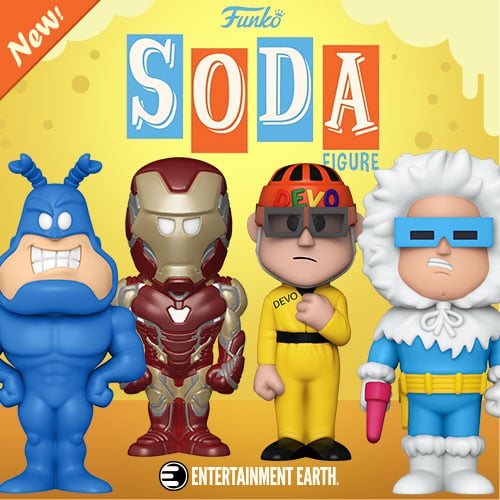Back in October, Syfy held a press event in Orlando, Florida. During the event the attending press was introduced to cast members from several Syfy shows including the brand new, Monster Man.
attending press was introduced to cast members from several Syfy shows including the brand new, Monster Man.
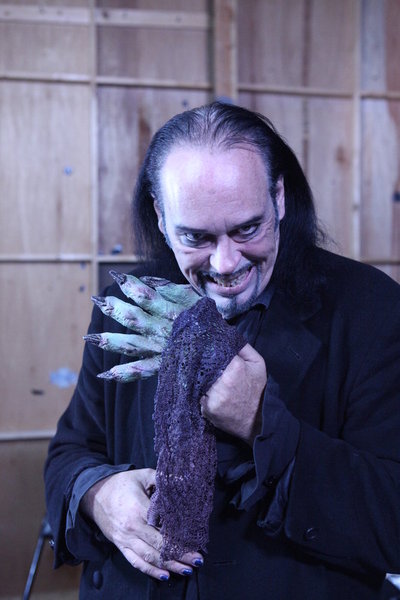 Monster Man is a behind the scenes look at Cleve Hall monster maker extraordinaire whose credits include movies and music videos. Cleve is joined on the show by his daughter Constance making this a true family business. The following interview gives you a glimpse at what is sure to be a fascinating look at the world of creature creation. Read the interview and don’t forget to check out the show Wednesday night at 10pm. Only on Syfy!
Monster Man is a behind the scenes look at Cleve Hall monster maker extraordinaire whose credits include movies and music videos. Cleve is joined on the show by his daughter Constance making this a true family business. The following interview gives you a glimpse at what is sure to be a fascinating look at the world of creature creation. Read the interview and don’t forget to check out the show Wednesday night at 10pm. Only on Syfy!
MARK STERN: Our next panel is definitely going to wake you up, “Monster Man.” So we continue our role of reality series. This is really quite — there’s no question this is a unique one. It’s scheduled to premier in March of 2012. I don’t think that’s actually news. So I won’t do anything about that.
(Telephone app plays the sound of a cow.)
When studios want a bizarre creature — I’m sorry. I’m having too much fun with this. You don’t have to indulge me. I guess you don’t have a choice. When studios want a bizarre creature out of this world, an alien, they turn to Cleve Hall. And “Monster Man” is this out-of-the-box docuseries the father, Cleve, has worked up in this very unconventional family, many of whom work within — in his workshop, including his daughters, Constance and Elora — Constance is here with us — his ex-wife, Sonja. And he also works with his business partner, Roy Knyrim, who is also with us today, Johnny Saiko, and the office manager, Cindy Miller. So this is definitely a show we are very excited about. I think it’s going to fit really beautifully with the other things we are doing. In particular, it’s kind of a horror look at makeup effects in the way that “Face Off” is kind of playing in that space as well in a very different space. So we are very excited about that. Please welcome Cleve Hall, Constance, Hall, and Roy Knyrim.
(Applause.)
MARK STERN: Come on.
CLEVE HALL: How are you doing?
MARK STERN: Good. How are you?
CLEVE HALL: Good to see you.
CONSTANCE HALL: Hey.
MARK STERN: Hey. How are you?
ROY KNYRIM: Hi.
MARK STERN: Have a seat.
CLEVE HALL: Thank you. I almost wore that today. So I’m really glad that I didn’t. I went another way. So welcome, you guys. Thank you. How are you doing?
MARK STERN: Your contacts are freaking me out right now. (Cleve was wearing red contacts)
CLEVE HALL: Freaking you out?
MARK STERN: Thanks so much for doing that.
CLEVE HALL: At least you recognize that they are contacts. Some people are like, “Are those your eyes?” And I’m like, “Yeah, devil eyes.”
ROY KNYRIM: I called him earlier. I said, “Your eyes are a little red today, Bro.”
CLEVE HALL: Yeah.
MARK STERN: You’ll see these later. Let’s cook something. So we actually have some footage. You guys are in the middle of shooting the show now. So some of this is — actually, most of this is stuff that the marketing guys have done because they are still in the midst, but I will tell you that what we are seeing is really, really amazing.
CLEVE HALL: This is just the big half of it.
MARK STERN: Check it out.
(Clip shown.)
MARK STERN: So that’s, like, just a various glimpse right there.
CLEVE HALL: I know. That’s pretty — catches it pretty much right there.
ROY KNYRIM: Yeah.
MARK STERN: So please tell us. Where did this series come from? And where did the idea for this series start?
CLEVE HALL: Well, I’ve always been a firm believer of being in the right place at the right time. Roy called me at midnight one night, and production needed the back of a huge whale for a shoot for a reality show about animals that attack. So I’m like, “Okay.” I’m out at a nightclub, and so, about 2:30, the club closes. I went back to the shop and made it. 6:30 rolls around and I tried to put it in my hearse, and I can’t fit it in my hearse. So I strapped it to the top of the hearse. And I get out, makeup smeared, and I’m covered in latex. And I said, “Who is this?” And they just thought that was hilarious. They said, “We are doing a reality show about you.” And I’m like, “Yeah, right.” And they did.
MARK STERN: Wow. Okay. Yeah, that’s not usually how those reality shows start. I know. And I think what’s amazing about this is, you know, obviously, this is a real workshop. Your relationship with your family is fascinating to watch. Also, I think what’s really great, just watching the footages, you know, you are a fabricator in your own right. There’s a really interesting dynamic with you and your dad that, you know —
CLEVE HALL: She’s been working with me since she was 13.
CONSTANCE HALL: Ten years.
CLEVE HALL: Ten years now.
MARK STERN: And there’s this great — I think what’s really relatable is that fact that you have your own way of doing things there’s. This real push and pull. Talk about that a little bit.
CONSTANCE HALL: Sometimes we get along and, you know, like, work perfectly, you know, like a well-oiled machine, and sometimes we don’t. Sometimes it’s a little more difficult, you know.
CLEVE HALL: Like, I get really, really focused on creating these things, and a lot of it I do in my head, build in my head. And I’m staring at the foam and stuff, and she’s just like, “Come on.” I have my way of doing it, and then she starts to work on it. And I say, “Don’t do that. That’s not the way I want it. Yeah, Whoo.
MARK STERN: And does she surprise you? I mean, are there things that suddenly come out?
CLEVE HALL: Yeah. Actually, she does some of the things that when I don’t — when I don’t do the project, I run — like, totally stay away from making it and she does it herself, it’s awesome, you know. If she’s working with me, sometimes then she’ll rely on my skills and stuff to kind of to show her what to do. But if I just pretended to die or something and she was left on the run, then she does a great job.
CONSTANCE HALL: We just have different ways of doing things. I’m all about trying new things, and he’s all about keeping it —
CLEVE HALL: Yeah. I sent her, actually, to a really good makeup school to, like, learn a lot of new stuff, materials and stuff that are out there. It turned out some of the teachers — Guy Psycho was one of the teachers at the school, and I was in there going, “Her dad taught me how to make molds.” She’s was like —
CONSTANCE HALL: I was just trying to skate through without anybody knowing it.
CLEVE HALL: Yeah. He ask if her daughter was in there. It was like, “Okay. I blew that one.”
MARK STERN: And, Roy, where are you in this whole mix?
ROY KNYRIM: Well, I own and operate SOTA F/X. Cleve and I have been pals for, like, 20 years. She’s been my head designer/fabricator for probably, like, 10 now?
CLEVE HALL: Yeah.
ROY KNYRIM: Ten years. And it’s kind of all in the family. It’s just been a long, crazy run. He started bringing Sonja and Constance, his own daughter, around.
CLEVE HALL: Yeah. I have my team that I use, which is basically of my family and Johnny, and it’s like, you know, we come in. And he gets these great jobs because a lot of this stuff is with bands. I was working for —
ROY KNYRIM: Yeah.
CLEVE HALL: — KISS and Alice Cooper and Devo. So it was like, you know, I come in to him, and he’s like — he’ll come to me first with stuff, and I’ll be, like, “Yes, let’s do this,” because I love the jobs he gets. It’s a lot more fun than doing big food for Snapple, big fruit, you know. That was what I used to do.
MARK STERN: Although we love Snapple.
ROY KNYRIM: Yeah. I mean, we are very fortunate. I mean, about 12 years ago, when digital started taking over for a lot of things, so I made a really conscious effort to try to do a lot of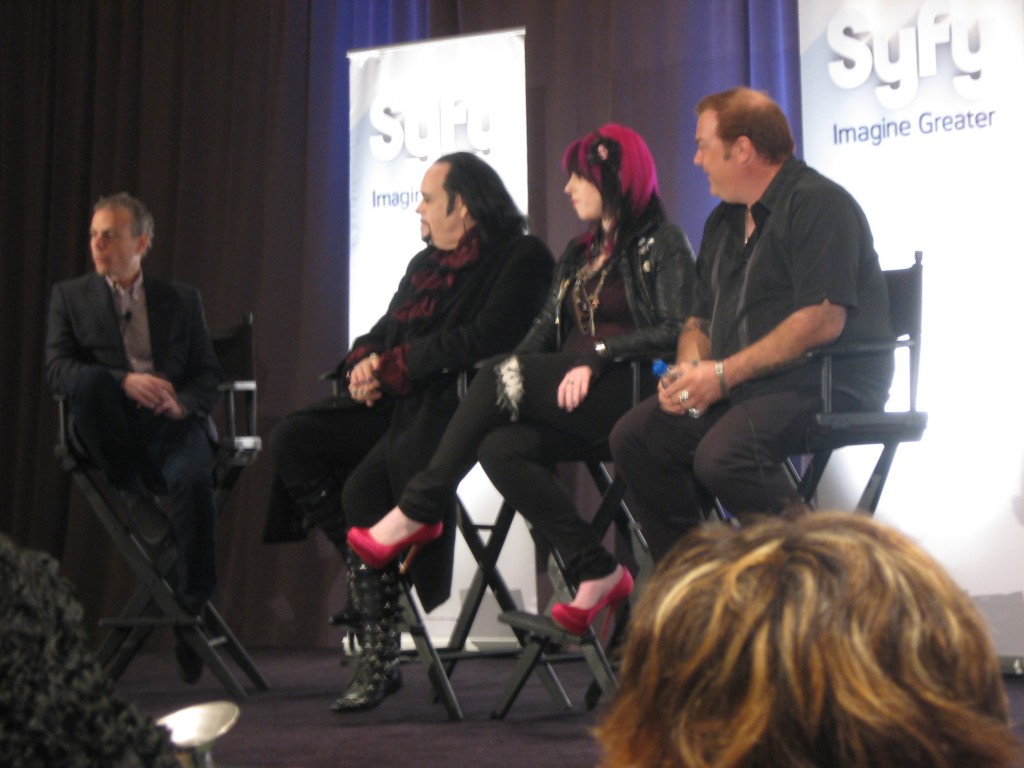 live-production stuff. So I started working with bands like Alice Cooper and Devo and The Insane Club posse, and we’d get to do touring sets. So a lot of monsters we do are for live stage shows, which is great because all of us kind of have a theatrical background.
live-production stuff. So I started working with bands like Alice Cooper and Devo and The Insane Club posse, and we’d get to do touring sets. So a lot of monsters we do are for live stage shows, which is great because all of us kind of have a theatrical background.
CLEVE HALL: And a rock ‘n roll background because my first album was Alice Cooper and building a lot of sharkies (ph). And, you know, when I say the cyclops and everything, that’s iconic to me.
ROY KNYRIM: Yeah. Last year we got to —
CLEVE HALL: We got to rebuild it.
ROY KNYRIM: We rebuilt Alice Cooper’s cyclops from his 1975 tour. For Cleve and I, it was dream.
CLEVE HALL: And, suddenly, it was like KISS doing a Gene Simmons drum roll. It was like, this is amazing. This is stuff from when I was in high school and everything as a rock ‘n roll kid.
ROY KNYRIM: Yeah.
CLEVE HALL: Yeah. I mean, doing the ghoul monsters and everything just — a lot of low-budget clips and films have come through there, and we get to do all kinds of creatures.Everything you see on the shows is perfect. Actual films, you come through, you know. It’s like —
ROY KNYRIM: Well, what’s great is we are a very working-class shop. We are always busy. We don’t — every once in a while, maybe every year or two, we will do one pretty-big-budget show,but we do a lot of lower- to medium-budget shows. Consequently, we have to do a lot of them at the same time.
CLEVE HALL: Yes, on top of each other.
ROY KNYRIM: So there’s monster after monster after monster that comes through the stop.
CLEVE HALL: Yeah.
ROY KNYRIM: It’s crazy.
MARK STERN: And do you feel like there’s this sense of it is a dying art with digital and CG?
ROY KNYRIM: For sure.
CLEVE HALL: We are survivors.
MARK STERN: And it’s interesting that you are kind of passing this on now to your daughters as well.
CLEVE HALL: You know, I don’t think it’s going to die. I hope it doesn’t die. There’s always room for it. I think CG is — you know, it’s a good compliment to the physical effects. It shouldn’t replace them. And to them, for those new CGs, it takes out the “how did they do that” aspect of special effects because I grew up with Ray Harryhausen, and those films just — those gripping scenes, these amazing effects, it’s like now you know how they were done.
ROY KNYRIM: We’ve been doing a lot of stuff for Syfy original movies. We did “Swamp Shark” —
CLEVE HALL: We have.
ROY KNYRIM: — “Monster Wolf” —
CLEVE HALL: We just did “Naked Spider.”
ROY KNYRIM: — “naked Spider.” And what’s been great is we’ve been doing a lot of practical stuff augmented digitally. And I think the actors really like this because they have something there that they can work with, and then, later on, they go, and they augment it to make it better imposed.
CLEVE HALL: And also, for some of these directors, if you bring in something that is a physical effects and you show them, “Hey, 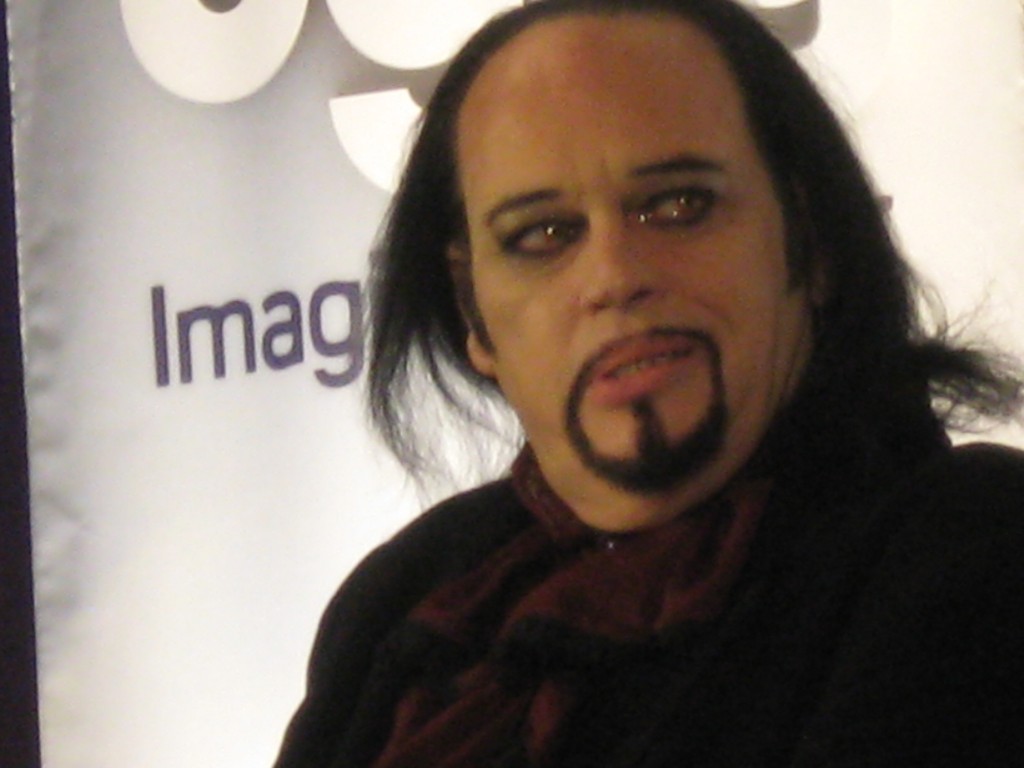 you don’t have to shoot this digitally. You can do this on set with this thing.” Actors love working with it. You bring in cool things — Tony Randall was awesome because he’s — these older school directors who work with physical effects, they are the ones — they really want it. Some of these newer guys who have never done physical effects are kind of stared of them.
you don’t have to shoot this digitally. You can do this on set with this thing.” Actors love working with it. You bring in cool things — Tony Randall was awesome because he’s — these older school directors who work with physical effects, they are the ones — they really want it. Some of these newer guys who have never done physical effects are kind of stared of them.
ROY KNYRIM: Yeah.
CLEVE HALL: It used to be the rule was when he first filmed, never work with children and animals. Now it’s children animals and physical effects.
MARK STERN: Interesting. Why don’t we — why don’t we open up the floor.
QUESTION: Hey there. You mentioned Ray Harryhausen, and there’s a lot of guys out there in the past that have done some amazing work. But, for you, who really, like, set the bar? What is the — let’s say this: Who created the creature that, for you, is like the Mona Lisa, the thing you always inspire for? Like, what is that?
CLEVE HALL: Eiji Tsuburaya created Godzilla in 1954, and that was like — that was the iconic creature to me. My mother loved monster movies. I hated baby-sitters. So she was taking me to movies when I was one year old. I saw “Mothra” and “Gorgo,” but when I saw Godzilla versus the thing in, like, ’65 and that was Godzilla fighting the giant Mothra, it was like, from that moment on, I knew who I wanted to be. I wanted to be Godzilla. And I finally got to be Godzilla because I did Huey’s big adventure and I got to play Godzilla in that.
QUESTION: That was you?
CLEVE HALL: That’s me.
QUESTION: Awesome. And, Constance, what are you aspiring for? Like, what’s your ultimate creature?
CONSTANCE HALL: Honestly, I’ve already done, like, a lot of dream jobs, as it were, like geeks and stuff.
ROY KNYRIM: Yeah. You are very fortunate.
CONSTANCE HALL: Yeah. But it’s like, what I’m inspired by, those kinds of creatures, classic universal monsters, I love, you know, the creature from the black lagoon, Freddy Frankenstein, and, I mean, that’s kind of what I’m into, you know, like –yeah.
CLEVE HALL: The old-school monsters because, you know, monsters from the ’70s when it turned into slasher films, it’s just not the same.
CONSTANCE HALL: I’m not a big —
ROY KNYRIM: Well, except for — I mean, the pinnacle of makeup effects, I think, was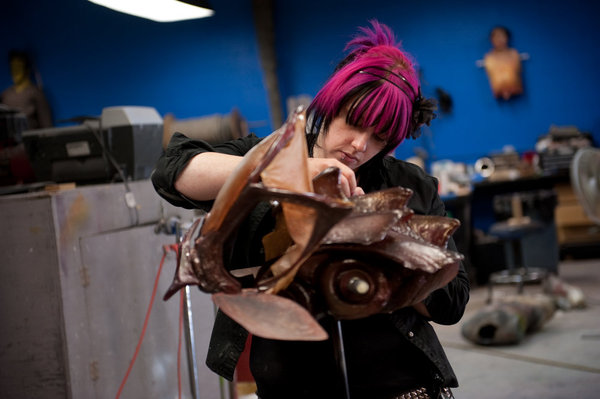 1982, with “The Thing” —
1982, with “The Thing” —
CLEVE HALL: Yeah.
ROY KNYRIM: — John Carpenter’s “The Thing.” That’s never been surpassed, and there’s not one digital optical effect in those creatures.
CLEVE HALL: Yeah.
ROY KNYRIM: It’s unbelievable.
QUESTION: Over here. Our audience is really excited for the show, and we’ve kind of been pulling through the helipoint that you just did a couple weeks ago. But I just wondered if you could talk about, what’s the premise going to be? Are you going to do kind of like one movie or one effect per episode, or how does it work out?
CLEVE HALL: Well, the structure right now I believe the show is going to follow is that we have one A build, we call it, one main creature that we are working on, and then there’s usually a B build, which is another project we are doing at the same time. And that’s like, you know — the only thing that lacks realism there is there’s actually three projects going on at once. Yes, it has us losing our minds and ripping our hair out, trying to get everything done by the deadlines, but the show will focus on one main creature and then a secondary project going on at the same time.
ROY KNYRIM: And the way we work, there’s literally someone at our shop 24 hours a day, seven days a week.
CLEVE HALL: We never go home.
ROY KNYRIM: There’s no way we would ever get the things done in the time schedules that we get.
CLEVE HALL: They send in cat food at times so that they can feed themselves.
MARK STERN: I will say that it’s been very interesting shooting this show, at least from what I’ve heard, as if I’m standing on set with you guys, that so much happens in your head that getting it out on paper —
ROY KNYRIM: Oh, yeah.
MARK STERN: — to see your process has been a very interesting experience.
CLEVE HALL: Yes. It’s really different for me because I am very much — I do build things in my head. I’ll stare at foam for two hours and build it in my head. And working on a reality 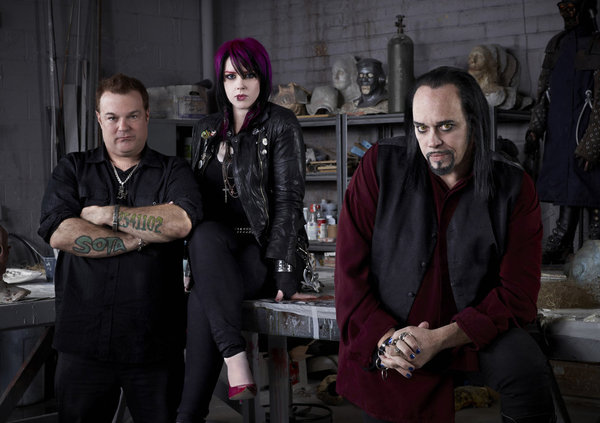 show, that doesn’t make for good television. They want me to explain what I’m doing. So I’m like, “Help.” Yeah. The first three days, I locked myself in my room, and then I finally came out and was like, “Okay. I can do this,” and it was awesome.
show, that doesn’t make for good television. They want me to explain what I’m doing. So I’m like, “Help.” Yeah. The first three days, I locked myself in my room, and then I finally came out and was like, “Okay. I can do this,” and it was awesome.
MARK STERN: Was that — Constance, was that like wish fulfillment for you? Like, finally, he gets to have to put it on paper?
CONSTANCE HALL: Well, he doesn’t even actually put things on paper as much as I do. Like, he just —
CLEVE HALL: She draws better than I do.
CONSTANCE HALL: You just kind of like — he’ll tell you what to do, like, “Oh, make this. Make that,” and it will be like,”Where is this going? until the very last moment. It all comes together. I like to draw things and try to, like, plan it out and have schematics or whatever. I just like to plan it and have it there. So —
CLEVE HALL: The reason for this being also — sometimes I don’t have a finished thing in my head.
ROY KNYRIM: Yeah.
CLEVE HALL: I have a visual idea in my head what I want, but I create as I go, and it’s not until the last 48 hours, okay. Bam. It suddenly hits me.
ROY KNYRIM: Yeah.
CLEVE HALL: This is what I want. This is what I’m doing.
ROY KNYRIM: And that’s not great to have a series of.
CLEVE HALL: Yes. That’s why I was having a hard time. He’s crawling across the floor, touching his chest.
ROY KNYRIM: It’s like, “Hey, Cleve, Tony Randall wants to come over and see his creature.”
CLEVE HALL: And I’m like, “Fine.”
ROY KNYRIM: It’s a pile of foam sitting on the table.
CLEVE HALL: He’s always seen something in his head that he couldn’t describe or draw.
ROY KNYRIM: Yeah.
CLEVE HALL: And he looked at my big pile of stuff and saw it, you know. He was awesome to work with.
ROY KNYRIM: But the other thing, too, is that’s what’s magical about it is that you’ll see it go from a pile of foam on the table to a creature that’s in a movie, and that’s —
CLEVE HALL: Sometimes in the last 24 hours.
ROY KNYRIM: But for all of us that have been doing this — Cleve has been doing it for 30 years, and I’ve been doing it for almost 30 years. And to this day, that still magical for me to see this pile of stuff turn into a monster.
CLEVE HALL: Because I will canoodle something until the last half an hour. For 24 hours, Constance and I are like this machine, four arms and it goes — and it always — we always make our deadlines. We always have it there. Sometimes you are an hour late, but it’s always there to shoot.
CONSTANCE HALL: It points to Roy for being so, you know, understanding and trusting.
CLEVE HALL: This guy doesn’t want to hear the truth.
CONSTANCE HALL: It’s probably like, “This suit needs to be done there’s nothing” — you’re like, “Oh, yeah. I just need to do this.” He’s like, “Okay.”
CLEVE HALL: He’s running — you ask me anything, and you are going to get my answer. “How is it going? Awesome,” because I will never accept the fact that things aren’t going awesome. I know, in my head, it’s going to be done. I won’t accept the fact that it will not be done no matter how stressed I am. So — and he doesn’t want to hear the truth anyway.
ROY KNYRIM: No.
CLEVE HALL: He just wants to hear that everything is awesome.
CONSTANCE HALL: It is awesome.
MARK STERN: That’s good. At least he has your back when it comes to talking to business people.
CLEVE HALL: Which is why my -ex, Sonja, drives him insane because she’s like, “This will never going to be done. It will never be done. You might as well call him and tell him it’s never going to be done.” And he’s, “Don’t say that.”
ROY KNYRIM: On Thursday, when we get back, I’m directing a music video for Devo, and Cleve is making creatures for it. And he’s in with the creature suits. And the stuff is almost done, but it’s not done.
CLEVE HALL: Yes.
ROY KNYRIM: And Sonja, his ex-wife, is like, “It’s never going to get done.” It’s like, “Gees, don’t tell me that.”
CLEVE HALL: Yeah. He can’t handle that. Please don’t do this. You are killing me, Roy.
MARK STERN: All right. We are getting under Cleve tonight, then, apparently.
QUESTION: What’s the craziest creature you’ve ever created in a while?
CLEVE HALL: The what?
QUESTION: Craziest, whackiest.
ROY KNYRIM: The craziest creature you ever made.
CLEVE HALL: Craziest? I think the craziest might actually be –oh, no, the terrorism monster would probably be craziest. Tony Randall’s thing was crazy in that that was, like, nothing, no design whatsoever, and we were just trying to pick each other’s minds as to what we were seeing because he had more of a feeling of horror that he wanted to convey but could not describe this biomechanical creature.
ROY KNYRIM: Yeah. We get — a lot of times the worst thing we want to hear is when a producer comes in and says, “I want to have a creature that’s never been seen before.”
CLEVE HALL: Yeah.
ROY KNYRIM: And, usually, my answer is that “99.9 percent of the time that we’ve never seen this creature before is because it sucks.”
CLEVE HALL: Yeah. That’s a good point.
ROY KNYRIM: So that’s the hardest thing for us.
MARK STERN: Okay. We’ve got one more — time for one more question. Michelle?
QUESTION: Actually, I have a two-part question. The first question is who are your influences? And then the second question is how collaborative is the monster-making process with the producer? Like, generally, what percentage of producers come in knowing exactly what they want the monster to look like, and then you push back and say, “No, no. That’s not really correct,” or do you just say, “Okay. If you want to have it with a hand, we’ll give it to you.” And then what percentage of producers come in who have no clue as to what that want?
MARK STERN: Okay. Well, the first part of your question, my influence is Eiji Tsuburaya, who created Godzilla, Jack Kevan, who did the “Creature from the Black Lagoon,” and Rick Baker, “American Werewolf,” and stuff. He’s actually been a friend from like the ’70s. Those are my main influences and Ray Harryhausen because he did start out as an animator before he got into makeup. But that’s also bring a creature to life, just in a different style. As far as — what was the second half?
CONSTANCE HALL: Producers.
ROY KNYRIM: Oh, producers.
CONSTANCE HALL: It depends. Some actually are very incredible. Like, some are very insistent in, like, they know exactly what they want, and it cannot differ in any way from that design, whereas some are just, like, we want a werewolf-type thing and let you go for it. So it really depends.
ROY KNYRIM: I would say it’s almost half-and-half.
CONSTANCE HALL: Yeah.
ROY KNYRIM: It seems like more and more people now don’t have an idea when they come in because they try to do so much imposed.
CLEVE HALL: Yeah.
ROY KNYRIM: It seems the people that want to do their practical stuff have at least some kind of idea when they walk in. But when you work more of the old-school directors — Cleve ended up working for, like, Tony Randall, who did “Hellraiser II”; Shawn Cunningham, who did “Friday The 13th”; Richard Elfman, who did “The Forbidden Zone” — they know what they want. Like, those kind of directors walk in, and they know almost exactly what they want. It’s kind of the newer people that don’t.
did “Friday The 13th”; Richard Elfman, who did “The Forbidden Zone” — they know what they want. Like, those kind of directors walk in, and they know almost exactly what they want. It’s kind of the newer people that don’t.
CLEVE HALL: Yeah. It’s like — because, I mean, I brought myself — when I nail a design, I nail it. If it’s a design that I feel is bad, I will try and convince them not to do it that way, maybe do something a little different. But if push comes to shove and I can’t convince them otherwise, then we do that creature.
ROY KNYRIM: Yeah. I mean, ultimately, what’s very hard for us and for Cleve is it’s commercial art. I mean, we are being hired to build their vision, and we try to steer them in the direction of what we want to do, but ultimately, we have to build it.
CLEVE HALL: Because we figure we have pretty good taste in monsters.
MARK STERN: Yes, you do. Okay. With that, thank you, guys. They’ll be down here to chat with you. Thank you very much.
(Applause.)
Don’t forget to tune into Monster Man premiering this Wednesday at 10pm only on Syfy!

